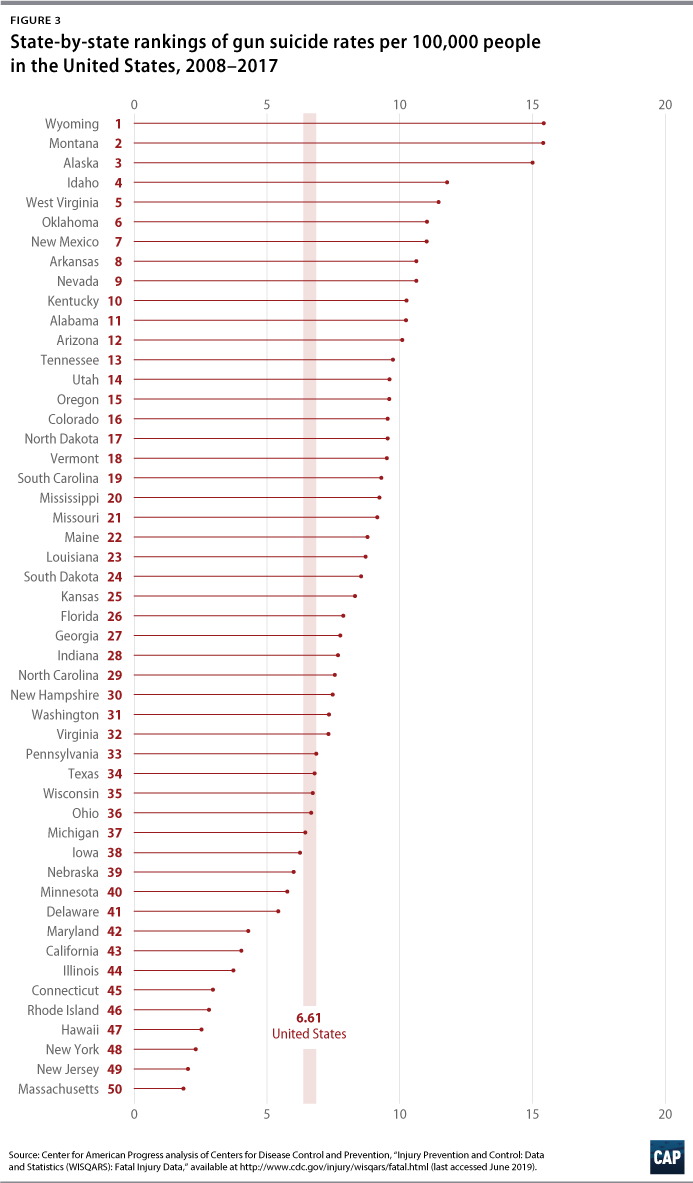More than 342,439 people were shot to death in the United States from 2008 through 2017, meaning that a person is killed with a gun in this country every 15 minutes. But the gun violence crisis in the United States is not monolithic; rates of gun violence vary widely from state to state, as does the character of that violence. Some states report relatively low rates of gun-related homicides but high rates of gun-related suicides, while other states have the exact opposite experience. Still others see both or neither trend, meaning overall high or low rates of gun violence across categories. Alaska, Louisiana, Alabama, and Mississippi rank in the top four for highest rates of gun-related deaths, with rates that are higher than 18 gun deaths per every 100,000 people. In contrast, New York, Rhode Island, Massachusetts, and Hawaii are at the other end of the spectrum, with rates lower than five gun deaths per every 100,000 people. (see Figure 1)

Gun-related homicides
More than 35 percent of gun deaths in the United States are gun homicides, meaning that close to 33 people are murdered with a gun every day. The gun homicide rate in the United States is 25 times higher than in other high-income nations. Among states, however, disparities in gun homicide rates are significant: Four states present rates of gun homicides that are higher than six per every 100,000 people. In contrast, five states present rates lower than one gun homicide per every 100,000 people. (see Figure 2)

In a majority of states, gun homicides disproportionately affect communities of color. For example, while Black Americans represent around 15 percent of the population in Michigan and New Jersey, they account for more than 74 percent of gun homicides victims in those states. In New Mexico, Hispanics make up close to 47 percent of the population but are victims of 60 percent of gun homicides. American Indians and Native Alaskans are also disproportionately affected: In Alaska, Native Alaskans make up 16 percent of the population and account for 27 percent of gun homicide victims, while in North Dakota, American Indians make up 5 percent of the population but are victims of more than 20 percent of gun homicides. Gun-related homicides are also prevalent in the context of intimate partner violence. The author’s analysis of the FBI’s Supplemental Homicide Reports shows that from 2007 through 2016, more than 5,250 women were murdered with a gun by an intimate partner.
Gun-related suicides
While gun homicides dominate media coverage of gun violence, the largest category of gun deaths in the United States is suicide. Suicide by firearm accounted for 61 percent of all gun deaths from 2008 through 2017. During that period, the United States had a rate of 6.61 gun suicides per every 100,000 people—eight times higher than the gun suicide rates of other developed nations. Rates of gun suicides vary significantly across U.S. states: While Wyoming, Montana, and Alaska presented rates higher than 15 gun suicides per every 100,000 people, nine states presented rates lower than five gun suicides per every 100,000 people. (see Figure 3)

Unintentional shootings and nonlethal gun violence
One other type of fatal gun violence that makes headlines is unintentional shootings, which often involve children. Unintentional shootings accounted for approximately 2 percent of gun deaths from 2008 through 2017. This means that during that period, an unintentional shooting death occurred every 16 hours, taking the lives of 5,327 people. Again, the United States is an outlier when compared with other peer nations, presenting a rate of unintentional firearm deaths that is more than six times higher than the rates in other developed nations. One in every 4 victims of fatal unintentional shootings is younger than 21 years old.
Lethal gun violence is only part of the problem: Shootings have a devastating impact on communities even when no one is killed. Data on nonfatal shootings are less reliable, but an analysis by Brady United to Prevent Gun Violence found that more than 200 people survive a gunshot wound every day, often suffering injuries that lead to a lifetime of health complications. Guns are often used in the commission of other violent crimes, exacerbating the harm caused to communities by that criminal activity. According to data from the FBI, from 2008 through 2017, more than 1.5 million aggravated assaults involved a firearm, with rates varying significantly across the states.
Conclusion
As leaders in the United States grapple with how to address the gun violence crisis, they should consider a number of policy and programmatic solutions that would have a significant impact on reducing the gun-related deaths, injuries, and crimes in this country. At a minimum, policymakers should prioritize the following measures:
- Ban assault weapons and high-capacity magazines
- Provide adequate and sustained funding for local violence intervention programs
- Require background checks for all gun sales, including at gun shows and online
- Enable federal public health agencies to conduct research into gun violence
- Strengthen laws to disarm all domestic abusers
- Enact extreme risk protection order laws to provide a tool to help individuals in crisis
Gun violence is a public health crisis. While it may seem like an intractable problem, gun violence is not inevitable, and Americans should not live with the fear of being shot.
Eugenio Weigend is the associate director for Gun Violence Prevention at the Center for American Progress.